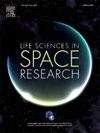Genome-wide chromatin accessibility and transcriptome analysis reveal the up-regulation of immunosuppressive genes in macrophages under simulated microgravity
IF 2.8
3区 生物学
Q2 ASTRONOMY & ASTROPHYSICS
引用次数: 0
Abstract
Long-term space missions are of growing research interest because of the space exploration. However, plenty of works focused on the impaired immune response, less attention has been paid to the activation of immunosuppressive or anti-inflammatory function. The molecular mechanism of immune disorder induced by microgravity still needs investigation. Here, we used a random positioning machine to generate a simulated microgravity environment and evaluated its effects on mouse RAW 264.7 macrophage cell line. We used ATAC-seq and RNA-seq for revealing the mechanism at chromatin level and gene level. From ATAC-seq, we obtained an average of 75,700,675 paired-end clean reads for each library and the mapping rates averaged at 96.8 %. The number of differential accessible regions were 510 for increased peaks, 638 for decreased peaks. From RNA-seq, we obtained 278 differentially expressed genes, of which 104 were down-regulated and 174 were up-regulated genes. Through ATAC-seq and RNA-seq multi-omics analysis, we identified a group of 17 genes. Then we chose 6 up-regulated genes (CD83, CEBPD, CXCR5, DUSP6, SEMA4B, TNFRSF22) that related to immunosuppressive function for further confirmation. The qRT-PCR results were consistent with sequencing results, which indicated that simulated microgravity leads to the up-regulated expression of immunosuppressive genes of macrophages. Taken together, our results offered novel insights for understanding the brief principles and mechanisms of simulated microgravity induced immune dysfunction to macrophage.
全基因组染色质可及性和转录组分析揭示了模拟微重力下巨噬细胞免疫抑制基因的上调
随着空间探索的不断深入,长期空间任务越来越受到人们的关注。然而,大量的研究工作集中在免疫应答受损方面,而对免疫抑制或抗炎功能的激活关注较少。微重力诱导免疫紊乱的分子机制还有待进一步研究。在这里,我们使用随机定位机产生模拟微重力环境,并评估其对小鼠RAW 264.7巨噬细胞的影响。我们利用ATAC-seq和RNA-seq在染色质水平和基因水平上揭示了其机制。从ATAC-seq中,我们平均获得每个文库的75,700,675对末端干净读取,平均映射率为96.8%。差异可达区为增峰区510个,减峰区638个。通过RNA-seq,我们获得278个差异表达基因,其中下调基因104个,上调基因174个。通过ATAC-seq和RNA-seq多组学分析,我们鉴定出一组17个基因。然后我们选择了6个与免疫抑制功能相关的上调基因(CD83、CEBPD、CXCR5、DUSP6、SEMA4B、TNFRSF22)进一步确认。qRT-PCR结果与测序结果一致,说明模拟微重力导致巨噬细胞免疫抑制基因表达上调。综上所述,我们的研究结果为理解模拟微重力诱导巨噬细胞免疫功能障碍的简要原理和机制提供了新的见解。
本文章由计算机程序翻译,如有差异,请以英文原文为准。
求助全文
约1分钟内获得全文
求助全文
来源期刊

Life Sciences in Space Research
Agricultural and Biological Sciences-Agricultural and Biological Sciences (miscellaneous)
CiteScore
5.30
自引率
8.00%
发文量
69
期刊介绍:
Life Sciences in Space Research publishes high quality original research and review articles in areas previously covered by the Life Sciences section of COSPAR''s other society journal Advances in Space Research.
Life Sciences in Space Research features an editorial team of top scientists in the space radiation field and guarantees a fast turnaround time from submission to editorial decision.
 求助内容:
求助内容: 应助结果提醒方式:
应助结果提醒方式:


